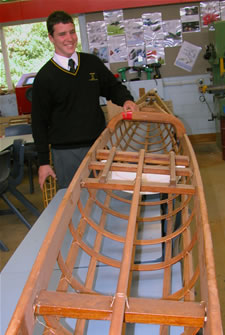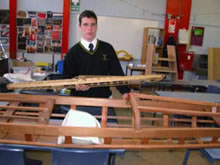Strip-built Racing Kayak
 Sam Notman
Sam Notman
Year 13 Materials Technology
Wellington College
Teacher: Matthew Lane
Sam's client was a multi-sport competitor who had a problem with his K1 (one-person) flat water racing kayak – it seemed too small for him and sat too low in the water.
He asked Sam to research the problem and come up with some solutions. Sam did so, and confirmed to the client that he was too big for his kayak and although modifications could be made, they would be expensive. A new kayak was the recommended solution. After further research as to technical requirements and costs, and discussions with a friend of his parents who had built boats as a hobby, it was decided that Sam would try building a kayak, strip-built from wood, within a budget of around $500.
Flatwater racing kayaks are generally made out of extremely lightweight composites such as Kevlar, carbon fibre, or fiberglass, and cost over $2,500 (being the basic minimum), but can also be strip-built from wood (commercially available for around $5,000). The hull and deck of strip-built kayaks are built with thin strips of lightweight wood, often cedar, as it has exceptional strength to weight ratio. The strips are edge-glued together around a form, stapled or clamped in place, and allowed to dry.
This forms a wooden shell, which is not inherently strong. The boat's strength comes from a layer of fiberglass or nylon cloth and epoxy resin, inside and out.
It was essential the kayak was constructed using the correct materials in the correct ways, as it had to be as lightweight and as strong as possible. "The client wanted a really light boat that he could carry and put on his car," says Sam. The client also wanted the kayak to be built for speed, and therefore to sit high in the water with minimal drag. Sam's research told him that this meant to design the boat with as little beam and to compensate with as much length as possible. For advice from on the correct woods to use, Sam consulted Wellington Timber Specialists.
"Wellington Timber imports a large quantity of cedar, and they supply a large number of boat builders in the area." The length of cedar strips required for the construction of the almost 5.5 meter kayak are not available, so Sam had to join them by dowelling and gluing. These were then lashed (to maintain flexibility) together to form the right shape and secured using ribbing made of recycled wood Sam had 'lying around'.
For the rudder, Sam used a wood that is lighter than balsa, and much stronger, but it is also porous, so it needed to be coated with epoxy resin.
The client had a seat moulded to his shape from a friend who specialises in such things, and Sam then set it in place. Its positioning was critical to the balance of the boat, so Sam experimented by balancing the kayak, see-saw-like, to find its 'sweet spot'.
 Once the kayak's framework was complete, Sam covered it temporarily with a heavy plastic skin and heat shrink-wrapped it
for full sea trials. The kayak passed with flying colours, and the client was delighted with the
results – so much so that, although he originally intended it for training, he now wants to race
with it. While the basic design of the kayak was taken from the internet, Sam had customised this
design to suit the specific needs of his client, making it longer and slightly wider. Teacher Matthew
Lane confirms that when he tried out the kayak in the trial, he did not feel at all comfortable – it was
obvious the kayak was designed for someone else. The design and fit of a racing kayak is essential. Customised versions rarely feel comfortable for anyone other than the client.
Once the kayak's framework was complete, Sam covered it temporarily with a heavy plastic skin and heat shrink-wrapped it
for full sea trials. The kayak passed with flying colours, and the client was delighted with the
results – so much so that, although he originally intended it for training, he now wants to race
with it. While the basic design of the kayak was taken from the internet, Sam had customised this
design to suit the specific needs of his client, making it longer and slightly wider. Teacher Matthew
Lane confirms that when he tried out the kayak in the trial, he did not feel at all comfortable – it was
obvious the kayak was designed for someone else. The design and fit of a racing kayak is essential. Customised versions rarely feel comfortable for anyone other than the client.
Sam will finish the kayak with epoxy-resin-coated nylon.
Teacher comment
 Sam is diligent and thoroughly steadfast in his approach to Technological problems. His earlier tests and mock ups explored shape and form,
balance and finish but it wasn't until he began the full blown construction the scale of his project
became apparent. There wasn't enough space at the college, and security was an issue, so we decided that their garage was the preferred location. He experimented with the structure of the kayak within the confines of his brief
and has managed to succeed in an impressive manner. Where problems arose Sam would model
solutions and discuss alternative approaches with experts he had contacted and befriended. His
ability to seek out and utilise the advice of other professionals has been one of his distinguishing hallmarks. The
project has taken more than 100 hours – many
on weekends and after school – and has been
punctuated with dismal weatherthat severely
hampered his progression from August
- October. Sam is an outstanding Technology
student, mature and mild mannered he has
persevered and won through!
Sam is diligent and thoroughly steadfast in his approach to Technological problems. His earlier tests and mock ups explored shape and form,
balance and finish but it wasn't until he began the full blown construction the scale of his project
became apparent. There wasn't enough space at the college, and security was an issue, so we decided that their garage was the preferred location. He experimented with the structure of the kayak within the confines of his brief
and has managed to succeed in an impressive manner. Where problems arose Sam would model
solutions and discuss alternative approaches with experts he had contacted and befriended. His
ability to seek out and utilise the advice of other professionals has been one of his distinguishing hallmarks. The
project has taken more than 100 hours – many
on weekends and after school – and has been
punctuated with dismal weatherthat severely
hampered his progression from August
- October. Sam is an outstanding Technology
student, mature and mild mannered he has
persevered and won through!
CP819 A Focus on Modelling
Wood/acrylic laminated coffee table showcase
This showcase was also featured in Tearaway magazine in June 2009






